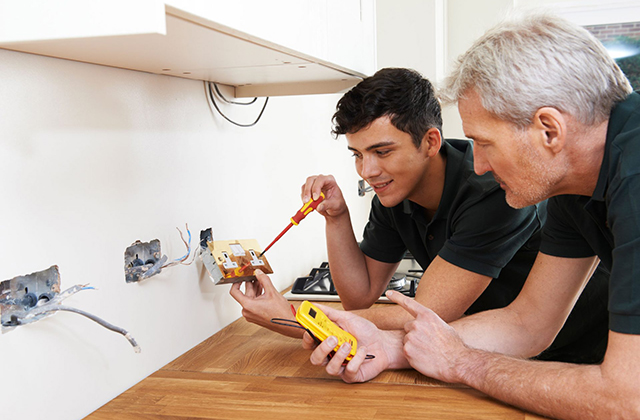2018

Is Your Home Wiring Safe?
The team specialise in after hours emergency electrician Brisbane, including small residential premises, high rise buildings, up to large commercial business facilities. As an Electrical Contractor, each day, I’m called upon to come to a residence and try and locate the reason that there are electrical issues or outages. I drive what I refer to as a rolling supply house stocked with over 10,000 residential electrical parts on my truck so that I am prepared to fix any problem on the spot. Getting back to the title question, residential wiring is usually still safe after many years of service. However, there are many different types of residential wiring, depending on the age of your home. Some of the very first electrical systems in houses and apartments was called Knob & Tube wire. It worked well at the time it was installed, pre 1920’s and into the 1930’s, but is no longer considered safe. Many insurance companies will not insure a home that still uses Knob & Tube wiring. During the 1930’s, steel conduit became the standard method of residential wiring. The conduit began at the fuse box and traveled from outlet box to outlet box, from wall outlet to light outlet to switch outlet. Wire was pulled through the conduit to each needed location for switches, lights and receptacles. In my opinion, this was the best method ever conceived, even to this day. During the 40,’s & 50’s, many homes were wired with a spiral steel jacketed cable called BX. Inside the spiral steel jacket were either 2 or 3 conductors, or wires, usually copper or sometimes steel. Steel was used often during WW2. After the BX stage of wiring came Romex. Today’s Romex is a plastic jacketed cable containing 2 or 3 conductors (wires) similar to BX. Romex and BX are very similar in that the outer jacket is stripped where it enters the outlet box so that the conductors can be spliced or attached to the switch, light fixture, or receptacle from inside the outlet box. Both the BX and the Romex were stapled by hammer to the joists & studs. BX was difficult to strip. Romex was much easier and faster to strip. A sharp knife is my preferred tool, whereas BX requires a special tool that cuts through the steel jacket. During the late 1940’s, there was Romex in existence, but the outer covering was a cloth and oil based substance. It changed to various types of outer coverings until the early 1970’s when it became the standard plastic covering that we continue to employ today.
The safest residential wire, in my opinion, is the type that is protected best from critters, nails, and any other means of cutting into the wire. Knob & Tube is definitely not safe. Early Romex tends to shred where stapled to studs and attic joists, causing the potential for a shorted circuit (when a hot wire comes in contact with the neutral wire or ground wire). A short is supposed to trip the circuit breaker or blow the fuse. If the breaker does not trip, the short will continue to get hot and can very easily start an electrical fire. If you own an older home, have a professional licensed electrical contractor come out and evaluate your electrical system. Did you know that in many older homes, the kitchen light fixture has burned up the wires in the outlet box above it? Most older kitchen lights use a sealed drum type of light fixture. The maximum wattage of light bulb for a sealed drum fixture is 60 watts. Many people over the years have installed 100 watt bulbs in their kitchen fixtures to make the kitchen brighter! The fixture becomes an oven.
The best wiring methods in my opinion are post 1970 Romex and also early steel conduit. With steel conduit, it’s so easy to completely rewire the entire house. Just connect new wire to the old wire and pull it through the conduit! And if you still have glass plug fuses instead of circuit breakers, it’s time for a meter upgrade or a panel change-out. Just today I went on a service call and quickly found the problem. However, I came across something inside the panel that had I not looked inside, the potential for a fire was possible. Someone had added a 15 amp circuit into the box. Instead of placing that 15 amp, 14 gauge wire on a new 15 amp circuit breaker, the electrician doubled it onto another breaker with a wire already attached. It was a 20 amp circuit breaker! Good thing I checked.
If you are concerned about whether or not the wiring in your older home is safe, you should call in a licensed electrician or electrical contractor to take a look and do a safety inspection. Often if you are having some repairs done, the contractor may do an inspection and give you a verbal report at no charge. If they are not already there, you can expect to pay a few dollars for an inspection, however the peace of mind you will have knowing your wiring is safe is worth a few dollars. Kind in mind to read more the safety guidelines before fixing your own electrical issues.
James Dent is an Electrical Contractor based in San Diego. He is the owner of Point Loma Electric, a residential electrical service company for over 23 years. James has a Master Electrician certification and began training as an electrician apprentice at the age of 17 at his fathers electric service company, Dent Electric, in Vienna Virginia.
Point Loma Electric serves all of San Diego County for both residential and commercial electrical issues. However, Point Loma Electric specializes in older homes residential service.
If you would like to know more, please visit our blog or website at http://www.PointLomaElectric.net
Article Source: http://EzineArticles.com/expert/James_L_Dent/719178
Article Source: http://EzineArticles.com/4759903